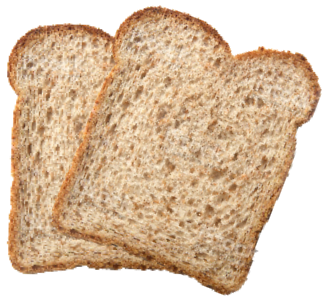What About
Diabetes?
Whole grains like wheat can play an important part in managing and reducing your risk of diabetes.

Whole grains like wheat can play an important part in managing and reducing your risk of diabetes.

Research shows a link between dietary fibre consumption and the reduction of diabetes.1
Diabetes affects people of all ages. It is a disease in which the body does not produce insulin, or the body cannot properly use the insulin it produces.
In 2022, 30% of Canadians (about 11.7 million people) were
living with prediabetes or diabetes.

Studies show that consuming 3-5 servings (48-80 g) of whole grains per day reduces the risk of developing type 2 diabetes by 26%.2
Wheat-based foods that are higher in whole grains and dietary fibre generally have a lower glycemic index, but pasta is a unique example of a refined wheat food that has a low glycemic index.

Looking for low GI meal ideas?

The glycemic index (GI) is a scale from 1 to 100 that ranks a carbohydrate food or drink based on how much it raises your blood sugar levels after consumption.


Did you know?
Reheating cooked and cooled pasta further lowers the GI value.


Did you know?
The fermentation process of making sourdough lowers the overall starch and sugar content of the bread, classifying it a low GI food.

Pasta made from durum wheat is a low glycemic index food
You may think pasta causes a “sugar spike” after eating since it is a carbohydrate-rich food. But in fact, the gluten in durum wheat pasta creates a compact structure which makes the pasta harder for our digestive system to break down. The longer and harder our body has to work to breakdown the carbohydrates into sugar, the longer it will take for these sugars to be released and absorbed into our bloodstream.


Visit Diabetes Canada for more information on the disease, risk factors, treatment and how to manage diabetes: https://www.diabetes.ca/
Since diabetes is a condition where the body cannot properly manage the glucose in the blood, and glucose comes from the foods we eat, it makes sense that dietary patterns can support or hinder the management of diabetes.
The majority of people living with diabetes are classified as overweight or obese, and obesity is a risk factor for developing type 2 diabetes. A healthy diet and active lifestyle are known to support a healthy body weight and the management of diabetes.
For more information on managing diabetes with diet, read this Diabetes Canada resource:
Supporting research shows a link between dietary fibre consumption and the reduction of diabetes. This is thought to be due to:
Studies show that increased intake of whole grains, including wheat, that are high in dietary fibre can help manage and may reduce the risk of diabetes. In fact, a review of 45 observational and 26 intervention studies showed that consuming 3-5 servings of whole grains per day (or 48-80 g of whole grains per day) reduced the risk of developing type 2 diabetes by 26%.
In addition, the fibre from cereal grains appears to help reduce the risk of diabetes more than the fibre from fruit. Cereal fibre, or mixtures of whole grains and bran, is also associated with a reduced risk of type 2 diabetes.
When it comes to refined grains, research shows that these food products do contribute to a reduction in diabetes risk. Reviews published on refined grain intake and risk of diabetes demonstrated no association when comparing those who consume the highest and the lowest amounts of refined grains. This is likely due to the lower fibre content of refined grains and speaks to the importance of including more whole grains in your diet.
Increasing resistant starches in our diet can have positive impacts on gut health, digestion, heart health and diabetes according to the latest scientific research.
Resistant starch can be found naturally in plant foods, and we can also create other types of resistant starches by how we cook, freeze, thaw, and re-use.
Most carbohydrates in your diet are starches. These are long chains of glucose (a sugar) that are found in plants including wheat. Starches are classified based on how quickly or slowly they are digested in the digestive tract.
Resistant starch passes through parts of our digestive tract unchanged and makes its way to our colon where it is fermented by the bacteria in our gut to produce short chain fatty acids.
The presence of short chain fatty acids are linked to several health benefits and disease risk reductions. These benefits are due to how they interact with our digestive system and because they provide energy (or food) for our gut bacteria and for us.
Research has looked at blood sugar levels in people who eat pasta that is cooked, cooled, and then reheated, as well as bread after freezing, thawing, and reheating (or toasting).
What they found in all these methods of cooling and reheating is a slower absorption of glucose into our bloodstream and thus a lower score on the glycemic index.
Why does this happen? The cooling process increases resistant starch content in pasta and bread by forming retrograded starch.
Retrogradation occurs when cooked starch is cooled, which causes starch molecules to form a crystalline structure that is resistant to digestion by the enzymes in our gut. This makes it harder for the gut to digest and absorb, delaying the absorption of glucose or sugar into our blood.
Resistant starch can support in diabetes management and help reduce the risk of other chronic diseases because it helps control blood sugar levels, among other reasons.

You may think pasta causes a “sugar spike” after eating since it is a carbohydrate-rich food. But in fact, the gluten in durum wheat pasta creates a compact structure which makes the pasta harder for the enzymes in our digestive system to break down. This slows the digestion and breakdown of the carbohydrates in the pasta and therefore slows the absorption of glucose into our blood. The longer and harder our body has to work to breakdown the carbohydrates into sugar, the longer it will take for these sugars to be released and absorbed into our bloodstream.
In general, wheat-based foods that are higher in whole grains and dietary fibre have a lower glycemic index, but pasta is a unique example of a refined wheat food that has a low glycemic index.
The Glycemic index (GI) is a scale (out of 100) that ranks a carbohydrate food or drink based on how much it raises your blood sugar levels after consumption. It is a tool that many people with diabetes use when selecting foods in their diet to help manage their blood sugar levels.
Our best data comes from intervention studies, where individuals are divided into groups and researchers introduce a specific intervention or change and measure the result. While the intervention studies that do exist may have more mixed results of the benefits of whole grain consumption related to diabetes, the role for dietary fibre in helping to reduce the risk of diabetes is clear. It is also important to remember that overall diet and lifestyle plays a role in diabetes risk, especially given the complex factors that affect an individual’s likelihood of developing the disease. Diabetes risk and the disease are affected by multiple lifestyle factors including diet and body weight, as well as non-modifiable factors like sex.

It is clear that wheat and whole grains have a positive or neutral effect on diabetes risk. Overall, data does not show that foods made with whole grains promote or increase diabetes risk.